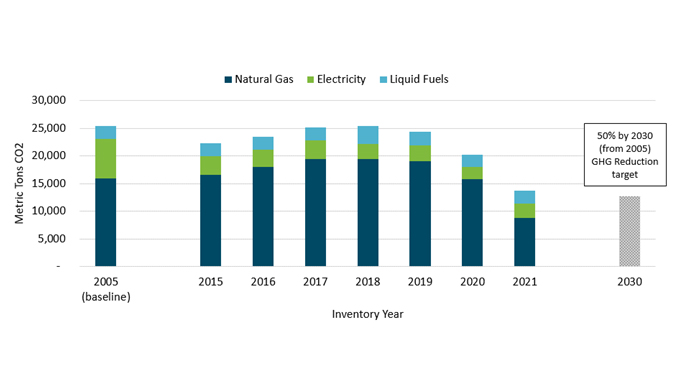
A national leader in sustainability initiatives, the Port of Seattle released its annual greenhouse gas emissions inventory today showing that it cut emissions from its own operations by 46 percent in 2021 over 2005 baseline. The Aviation Division became the first major operating division to meet the Port’s ambitious goal to reduce owned and controlled emissions by 50 percent by 2030. The massive reduction came almost entirely from the purchase of renewable natural gas produced from landfill waste.
The Port expects to eliminate all carbon emissions from Port-owned and -controlled sources by 2040 and for all entities operating at its facilities to be carbon neutral or better by 2050.
“We are past peak carbon for the Port’s owned and controlled emissions,” said Commissioner Ryan Calkins. “Renewable natural gas made this breakthrough possible. We are optimistic that more organizations will make major strides towards zero carbon when the Clean Fuel Standard takes effect in Washington next year. The biggest challenge ahead of us remains the 99 percent of Port related emissions that come from our aviation, maritime, and heavy transportation industry partners. Which is why the Port continues to push for large-scale transformative sources of energy like green hydrogen, sustainable aviation fuels, and renewable wind. Passage of the Inflation Reduction Act moves us closer to reaching these goals.”
Port-wide Scope 1 and 2 Emissions

The Port continues to pursue an aggressive transition to clean energy for its owned and controlled emissions at the airport and seaport. Changes for the next decade include electrification / decarbonization of the airport’s central boiler system, more seaport shorepower solutions and a clean energy strategy for the entire Seattle waterfront, electrification of the Port’s fleet vehicles, and a ground transportation plan for the airport to incentivize low carbon modes of travel to SEA Airport. To help transform industries to low and zero carbon energy sources, the Port continues to work for a local supply of sustainable aviation fuel. The Port also recently announced an effort to explore the feasibility of the world’s first cruise-focused “Green Corridor.”
The Port operations inventory measures emissions from Port-owned and -controlled sources like building facilities and vehicle fleets, referred to as scope 1 and 2 emissions. This inventory does not include Scope 3 emissions from other entities that operate at Port facilities, such as airlines and cruise lines. Port-owned and controlled emissions only comprise less than 1 percent of all Port-related emissions.
Aviation Scope 1 and 2 Details
- SEA Airport Scope 1 and 2 GHG emissions in 2021 decreased 50 percent from the 2005 baseline of 23,106 metric tons of CO2, meeting the Port’s Century Agenda 50 percent reduction goal eight years early.
- Replaced fossil natural gas with renewable natural gas in our boilers for heating fuel and in our bus fleet.
- Used renewable diesel in our fleet.
- Purchased PSE Green Direct wind electricity for buildings on the south end of the airport.
- View detailed Aviation 2021 Emissions results
Maritime Scope 1 and 2 Details
- Maritime and Economic Development Division Scope 1 and 2 GHG emissions in 2021, 2,200 metric tons of CO2, decreased 2 percent from the 2005 baseline of 2,255 metric tons, reversing a pre-pandemic trend of increases. Emissions prior to the pandemic in 2019 had increased by 12 percent over the 2005 baseline.
- GHG emissions from fuel use in maritime vehicles and equipment declined 41 percent since 2005 due to renewable diesel and lower gasoline use since pre-pandemic levels (2019).
- The reduction in gasoline use is likely due to fewer in-person meetings and less utilization of the motor pool as telework continued, as well as ongoing efforts to right-size the fleet and retire older, less efficient vehicles.
- View detailed Maritime 2021 Emissions results
Impact of COVID
COVID related changes in travel did not influence the outcome of the airport’s emission reduction results. While airport passenger volume recovered to just 85 percent of pre-pandemic travel, operations to run buildings and vehicle fleets were quite close to pre-pandemic levels. Impacts of the pandemic continued to be felt on the Maritime and Economic Development Division, particularly with lower natural gas use at waterfront properties, fewer cruise calls with a shortened season, slower bookings at Port-owned conference facilities, and reduced employee usage of fleet vehicles.
Reporting Scope 3 Emissions
The drop in Port-owned and -controlled emissions, known as Scope 1 and Scope 2, does not include emissions from other entities that operate at Port facilities, such as airlines and cruise lines. Port-owned and controlled emissions only comprise less than 1 percent of all Port-related emissions. The Port set a goal that all entities operating at its facilities be carbon neutral or better by 2050. For maritime Scope 3, the Port partners with Puget Sound ports, government agencies, and industry associations to conduct a regional, airshed wide maritime emissions inventory for Puget Sound every five years. The 2021 Puget Sound Emissions Inventory will begin this year and publish by 2024. SEA Airport conducts annual Scope 3 inventories encompassing all airline and ground transportation emissions. The 2021 inventory will be published later this year.
Contact
Perry Cooper | Media Officer
(206) 787-4923 | [email protected]

